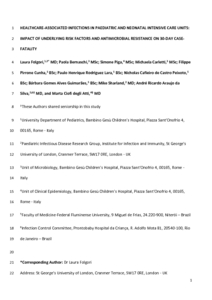Sharland, M;
Folgori, L;
Bernaschi, P;
Piga, S;
Carletti, M;
Pirrone Cunha, F;
Lara, PHR;
Cafeiro de Castro Peixoto, N;
Gomes Alves Guimares, B;
da Silva, ARA;
et al.
Sharland, M; Folgori, L; Bernaschi, P; Piga, S; Carletti, M; Pirrone Cunha, F; Lara, PHR; Cafeiro de Castro Peixoto, N; Gomes Alves Guimares, B; da Silva, ARA; Atti, MCD
(2016)
HEALTHCARE-ASSOCIATED INFECTIONS IN PAEDIATRIC AND NEONATAL INTENSIVE CARE UNITS: IMPACT OF UNDERLYING RISK FACTORS AND ANTIMICROBIAL RESISTANCE ON 30-DAY CASE-FATALITY.
Infection Control and Hospital Epidemiology, 37 (11).
pp. 1302-1309.
ISSN 1559-6834
SGUL Authors: Hubbard, Isabelle Anna
![[img]](https://openaccess.sgul.ac.uk/108089/1.hassmallThumbnailVersion/HEALTHCARE-ASSOCIATED%20INFECTIONS%20IN%20PAEDIATRIC%20AND%20NEONATAL%20INTENSIVE%20CARE%20UNITS%20-%20IMPACT%20OF%20UNDERLYING%20RISK%20FACTORS%20AND%20ANTIMICROBIAL%20RESISTANCE%20ON%2030-DAY%20CASE-FATALITY.pdf)  Preview |
|
PDF
Accepted Version
Available under License ["licenses_description_publisher" not defined].
Download (617kB)
| Preview
|
Abstract
Objectives.
Our aims were (i) to describe trends in the epidemiology of Healthcare-associated Infections (HAIs) in paediatric/neonatal ICUs and (ii) to evaluate risk factors and impact of Multidrug-Resistance (MDR) in children admitted to ICUs.
Design.
Multicentre, retrospective, cohort study
with a nested case-control study conducted between January 2010 and December 2014.
Setting.
Three tertiary-care paediatric hospitals in Italy and Brazil with a total of 97 ICU beds.
Patients.
Inclusion criteria were (i) admission to ICU during the study period (ii) age at onset <18 years and (iii) microbiologically-confirmed HAI.
Results.
538 HAIs in 454 children were included. 93.3% of patients had comorbidities. Bloodstream infections (BSIs) were the leading pattern (45.4%). The cumulative incidence of HAI was 3.6/100 ICU-admission and the crude 30-day fatality rate was 5.7/1,000-admission. The most frequently
isolated pathogens were Enterobacteriaceae, followed by
Pseudomonas aeruginosa and Staphylococcus aureus.44% of isolates were MDR. Two multivariate logistic regressions were performed. Factors independently associated with an MDR
-HAI were Country, previous antibiotics, transplantation, major surgery, and colonisation by an MDR strain. Factors independently associated with 30-day case-fatality were Country, previous transplantation, fungal infection, BSI, LRTI, and infection caused by MDR strains.
Conclusions.
Infection control and prevention should be a primary focus to limit the spread of MDR strains and improve the outcome of hospitalised patients. Targeted surveillance programmes
collecting neonatal and paediatric HAI/BSI data and outcomes would allow global benchmarking between centres. The next step is to identify simple methods to monitor key HAIs and integrate these into affordable intervention programmes.
| Item Type: |
Article
|
| Additional Information: |
This article has been published in a revised form in Infection Control and Hospital Epidemiology https://doi.org/10.1017/ice.2016.185. This version is free to view and download for private research and study only. Not for re-distribution, re-sale or use in derivative works. © 2016 by The Society for Healthcare Epidemiology of America. |
| Keywords: |
Epidemiology, 11 Medical And Health Sciences |
| SGUL Research Institute / Research Centre: |
Academic Structure > Infection and Immunity Research Institute (INII) |
| Journal or Publication Title: |
Infection Control and Hospital Epidemiology |
| Article Number: |
10.1017/ice.2016.185 |
| ISSN: |
1559-6834 |
| Dates: |
| Date |
Event |
| 2016-11-01 |
Published |
| 2016-08-11 |
Published Online |
| 2016-07-15 |
Accepted |
|
| URI: |
https://openaccess.sgul.ac.uk/id/eprint/108089 |
Statistics
Item downloaded times since 19 Jul 2016.
Actions (login required)
 |
Edit Item |


